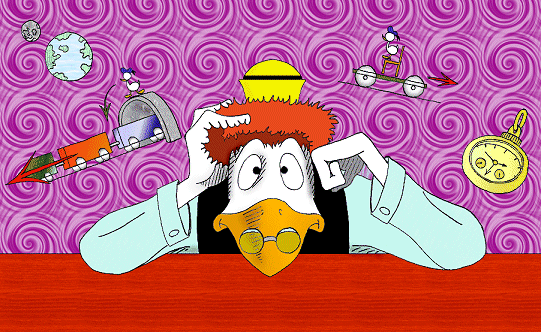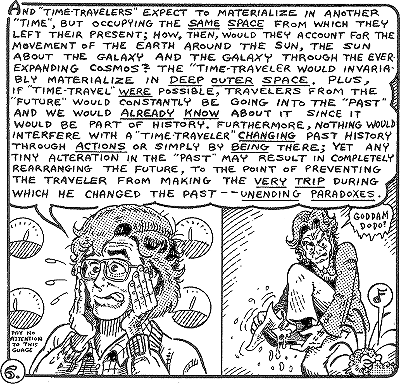
This
is an idea about time travel I had and wrote Keno Don Rosa about, who (as
usual) kindly answered me. It turned out he had the same idea several years
ago and used it in one story and mentioned it in one panel of "The
Pertwillaby Papers" ("Knighttime", Part 1). The latter were published,
along with his "Captain Kentucky" strips, in April 2001.
My e-mail
(slightly edited, with a note added) offers practical illustrations of
this theory. Mr Don Rosa's second e-mail (reprinted with his permission)
reveals how "Knighttime" would have ended had he been able to finish it,
thus disclosing another link between his Duck & Pertwillaby comics.
* * * * * * *
(O.B. to Keno Don Rosa ; February 17, 2001)
To begin with, let's say we'll skip all the discussion of time-space acting sort of like a piece of cloth which high density objects distort and that sort of thing.
A major
problem in time travel is where & when you land.
In the
recent British TV show "Crime Travel" (I believe it was the title; I rather
liked this series; I don't know whether there's been more of
it but in France we only got a few episodes-- about 3 years ago) the problem
is solved quite simply: the machine is inside a room and they can only
jump a day back at most.
In "Starlight"
(space travel through Hyperspace), Asimov's character explains the chances
of getting out of hyperspace into a star or an asteroid or
whatever are infinitesimal.
In Michael
Crichton's "Timeline", the machine first checks if there's anything
around, creates a protecting field around the landing area, then teleports
the travellers. (I like his use of the multiverse theory [1]
.)
In your
own story, Gyro solves the problem by chosing a site that hasn't changed
within period the the machine can travel back to: Stonehenge.
All these
precautions so that the traveller won't arrive in a spot where's there's
already something his body will mix with when re-materializing-- a problem
for teleportation as well if you imagine a technology which doesn't
need a target pod.
Fine.
But how can the traveller be sure there's even Earth?
Suppose
you're sitting on a chair on a moving platform. From an energetical point
of view, the platform, the chair and you form a system. Thanks to
friction, once you've started, you share the platform's kinetic energy
and move with it, but remain immobile in relation to it. If you stand
up on the chair and hop up (I mean, vertically, with no horizontal component),
you'll land in the
same
spot you've started from, on the chair on the platform.
Now when you're doing this you're hoping things won't change during the time you're in the air: if the chair falls back when you jump, you'll hurt yourself when you land. That's the gosh-I-hope-there-won't-be-a-fire-where/when-I-land-after-my-space/time-travel issue.
The problem is, why should there have been only that kind of change? Sure, maybe there used to be a castle on this now barren spot a hundred years ago. But then maybe there wasn't and you'll still have a problem because there wasn't even any land to land on (or into) at that time- and I'm not thinking of a lake instead.
Because you shared the platform's energy to start with, when you jump (within the platform's limit), whether it's a little hop (and you "stay in mid-air" f fractions of a second) or a big hop (and you stay in mid-air, say, 10*f fractions of a second), you'll still land on the platform because of the initial conditions which are thus that you're not hopping vertically in a strict sense but only in relation with the platform; to an observer standing on land, you'll still have a varying horizontal component, as you're still going along with the platform.
But suppose while you're moving up and down in the air the platform suddenly accelerates ten times or makes a sharp turn. Then it won't be there when you land.
Now, the Earth doesn't stand still. It orbits the sun and even spins on itself. In February it's here and in August it'll be way over there. And there's always a bit of a drift, what with the solar system and the galaxy and the universe expanding-- but that's over a much longer period of time than we'd want to travel back to, unless we want to know how it was back then, so we can neglect it, but still: the Earth is moving.
The vertical hop is the hop in time. The moving platform is the Earth.
In other words, time travel would be just like jumping onto a moving train from a bridge: you aim for a specific spot (car #2 for instance), but you can't reach it because it has moved while you were moving, and you land on car #3-- or worse, in-between and under the wheels...
Similarly, when moving back (or forward) across a long stretch of time, the chances are, Earth isn't there yet and you "land" in space-- or it is there, but instead of Kentucky, you land in India, because you moved back (forward) half a day to what was (will be) night in Kentucky but day in India (India may not be the exact spot; I won't check it, but since the Earth's spinning axis isn't perpendicular to its orbiting plane, I guess it wouldn't be straight down under).
So it would take quite a lot of complex calculations to make sure where you land and to take such parameters into account. And then, to determine the exact date of your arrival, you'd also have to take into account a certain 180° longitude line, wouldn't you? ; )
( Corollary
problems: so-called time-paradox (meeting oneself) and changing the course
of events. )

[1] The concept of multiverse has to do with chance & decision-making. Events are the result of either one or combinations thereof. For instance, if you miss the bus or decide for once to walk to work, the bus may have an accident in which you might have been seriously injured; if you had been, maybe you would have met a nurse you would have married and would have been happier with than with the woman you met walking to work. The idea is that each possibility gives birth to another universe, in which things are the same but for this difference; in the end, there are an infinite number of universes. The characters in the TV show "Sliders" explore such "what if" universes. Michael Crichton combines this theory and quantum mechanics to invent a time-travel technology; the traveler actually re-materializes in another universe.
* * * * * * *
(Keno Don Rosa to O.B. ; February 20, 2001)
You might be amused to know that back in the late 1960's I wrote and drew a short science-fiction comic strip for a fanzine that involved this EXACT IDEA.
A character was explaining how he needed to send a capsule into the future that, if it did not materialize inside something, would then pump a vacuum into which a space-suited time traveler could safely materialize. I think I see that going on in TERMINATOR 2 where just before the time-travelers materialize something eradicates everything in the spot they are being sent to, and I guess air then fills in the void, a much simpler idea.
Anyway, my whole story was this guy explaining how his plans for time travel would be the first to succeed, but the last panel shows him floating helplessly a trillion miles out in deep space because he has materialized in the precise spot in the future that he had left in the past... but, as you say, the earth revolves around the sun and the universe expands, so there is NEVER any hope of ANY time traveler to succeed. This is one reason I love time-travel stories, but I know the idea is rubbish, even when some supposed real-life "scientists" in the news start talking about their theories of it.
So, you
and I were having the same idea many years apart!
Sorry
I can't find any record of that old story -- it's one of the few things
I've ever done that is lost. I guess I sent it to a fanzine publisher who
never published it, so it's lost forever. The same thing happened to an
"underground art" style Donald Duck story I did about the same time...
maybe sent to that same magazine. Lost. I'd REALLY like to see that again.
* * * * * * *
(from "The Pertwillaby Papers", Chronicle 5: "Knighttime", part 1, p 6 / 167 panel 8)

When
Professor Horos Kronos is about to experiment his time machine on Professor
Viktor Dimitrius Smyte, Lance Pertwillaby interrupts them to save Smyte:
he is sure that time-travel is impossible and goes on to explain why and
the paradoxes it implies.
(A bit
more next page on Lance, the Ducks and Time
Travel)
* * * * * * *
(Keno Don Rosa to O.B. ; April 7, 2001)
I realize
I didn't tell you the whole story yet.
The
conclusion of the "Knighttime" story was to use this same idea, sort
of. The conclusion dealt with the idea that the characters had NOT traveled
in time, only switched to an alternate dimension. So they realized they
could still switch back
and
still be in the present time and not "lost in time". But when Lance sends
himself back (after he sends the others), it takes a fraction of a second
too long on his weak batteries, and he materializes in the upper atmosphere
(because the earth had MOVED during that moment of time). He then falls
to earth, protected by his air-tight helmet (as you see in the story).
What happens to him is the plot of "The Duck Who Fell to Earth" that
I did about 10 years ago [2] .
[2] KJD 108 / D 90 161 / DDA 37 (June '93)